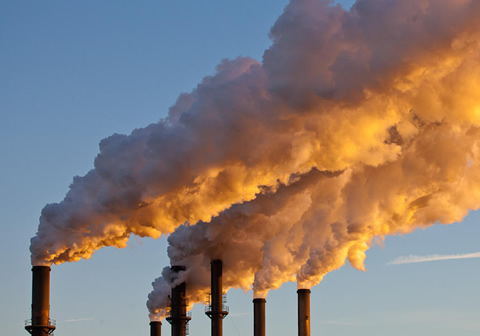U of T scientists have discovered a novel chemical lurking in the atmosphere that appears to be a long-lived greenhouse gas. The chemical – known as PFTBA, or perfluorotributylamine – is the most radiatively efficient chemical ever found in the atmosphere, which means that its potential to affect climate is greater than any other chemical on record.
“Calculated over a 100-year time frame, a single molecule of PFTBA has the equivalent climate impact of 7,100 molecules of carbon dioxide,” says Angela Hong, a PhD candidate in chemistry who was a member of the research team that made the discovery, along with Cora Young (BSc 2004 UC, PhD 2010) and Professor Scott Mabury.
Although its potential to accelerate global warming is very high, PFTBA currently exists in the atmosphere in very low concentrations – less than one part per trillion. (Carbon dioxide, which is used for comparison since it is one of the most common greenhouse gases, has been measured at more than 400 parts per million. This means there is about two million times as much carbon dioxide in the atmosphere as PFTBA.)
PFTBA has been in use since the mid-20th century in electrical equipment. It does not occur naturally, and has a very long lifetime – possibly hundreds of years. There are no known processes that would remove PFTBA from the lower atmosphere, but scientists believe that high-energy radiation destroys it in the upper atmosphere.
“PFTBA is extremely long-lived in the atmosphere and it has a very high radiative efficiency,” says Hong. “The result of this is a very high global warming potential.”
Read the original scientific paper in Geophysical Research Letters, 27 November 2013






No Responses to “ The World’s Worst Greenhouse Gas ”
This article should also explain how PFTBA gets from being "used in electrical equipment" to being a potentially suffocating vapour persisting in the atmosphere. Who's emitting it, by what processes, where, and in what concentrations. Then we can begin to think what to do.
Based on the article's information, at the current atmospheric concentration, PFTBA has a far lower impact on climate change than carbon dioxide.
Is there more information available in terms of the concentration trajectory of this chemical from the mid-20th century and in the last decade? If the usage has remained constant or moderately increased during this time-frame, then our immediate worry is still carbon dioxide.
Please include hyper-links (or end-note publication details) to studies that are central to articles such as these.
Thanks for the suggestion, Stephen. The link to the published article is:
http://onlinelibrary.wiley.com/doi/10.1002/2013GL058010/abstract
Unfortunately, a subscription is required to see the full text.
Has anyone done a material balance for CO2? What are the sources and amounts of CO2 that enters the atmosphere? What amount of CO2 is removed from the atmosphere by nature? What changes to these amounts have occurred in say the last 50 years?
It seems to me that we have a lot of scientists chasing solutions for reducing human source of atmospheric CO2 without any basis for measuring if the amount is relevant or even measurable. Are we solving a problem that does not exist?